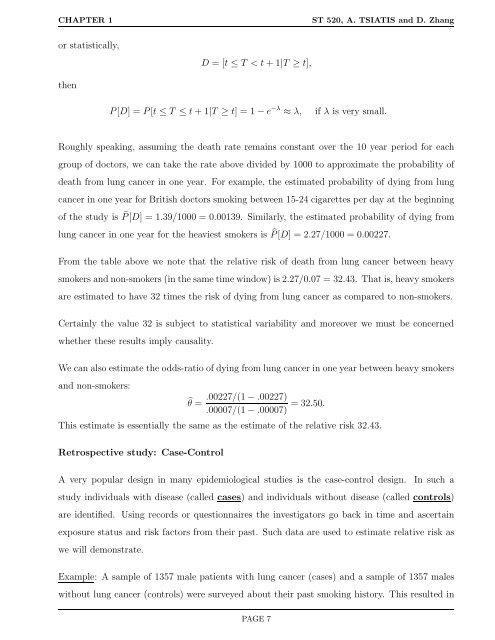ST 520 Statistical Principles of Clinical Trials - NCSU Statistics ...
ST 520 Statistical Principles of Clinical Trials - NCSU Statistics ...
ST 520 Statistical Principles of Clinical Trials - NCSU Statistics ...
You also want an ePaper? Increase the reach of your titles
YUMPU automatically turns print PDFs into web optimized ePapers that Google loves.
CHAPTER 1 <strong>ST</strong> <strong>520</strong>, A. TSIATIS and D. Zhang<br />
or statistically,<br />
then<br />
D = [t ≤ T < t + 1|T ≥ t],<br />
P[D] = P[t ≤ T ≤ t + 1|T ≥ t] = 1 − e −λ ≈ λ, if λ is very small.<br />
Roughly speaking, assuming the death rate remains constant over the 10 year period for each<br />
group <strong>of</strong> doctors, we can take the rate above divided by 1000 to approximate the probability <strong>of</strong><br />
death from lung cancer in one year. For example, the estimated probability <strong>of</strong> dying from lung<br />
cancer in one year for British doctors smoking between 15-24 cigarettes per day at the beginning<br />
<strong>of</strong> the study is � P[D] = 1.39/1000 = 0.00139. Similarly, the estimated probability <strong>of</strong> dying from<br />
lung cancer in one year for the heaviest smokers is � P[D] = 2.27/1000 = 0.00227.<br />
From the table above we note that the relative risk <strong>of</strong> death from lung cancer between heavy<br />
smokers and non-smokers (in the same time window) is 2.27/0.07 = 32.43. That is, heavy smokers<br />
are estimated to have 32 times the risk <strong>of</strong> dying from lung cancer as compared to non-smokers.<br />
Certainly the value 32 is subject to statistical variability and moreover we must be concerned<br />
whether these results imply causality.<br />
We can also estimate the odds-ratio <strong>of</strong> dying from lung cancer in one year between heavy smokers<br />
and non-smokers:<br />
�θ =<br />
.00227/(1 − .00227)<br />
= 32.50.<br />
.00007/(1 − .00007)<br />
This estimate is essentially the same as the estimate <strong>of</strong> the relative risk 32.43.<br />
Retrospective study: Case-Control<br />
A very popular design in many epidemiological studies is the case-control design. In such a<br />
study individuals with disease (called cases) and individuals without disease (called controls)<br />
are identified. Using records or questionnaires the investigators go back in time and ascertain<br />
exposure status and risk factors from their past. Such data are used to estimate relative risk as<br />
we will demonstrate.<br />
Example: A sample <strong>of</strong> 1357 male patients with lung cancer (cases) and a sample <strong>of</strong> 1357 males<br />
without lung cancer (controls) were surveyed about their past smoking history. This resulted in<br />
PAGE 7
















